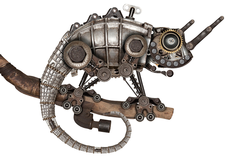Control USB-powered devices with a Raspberry Pi
Power Point

© Lead Image © Burmakin Andrey, 123RF.com
Command-line tools and Node-RED on a Raspberry Pi let you control projects that use the USB ports.
For home automation projects, a Raspberry Pi offers a simple, low-cost approach to managing and controlling a wide variety of devices. Typically these devices are either digitally wired 0-5V devices such as motion detectors, or wireless Ethernet devices such as smart plugs. It's important to note that a Raspberry Pi can also control USB-powered devices, such as USB fans, lights, and low-end controllers.
In this article, I look at how to monitor, control, and measure USB power in two Raspberry Pi projects. The first project uses Node-RED to create a web dashboard to monitor and control USB lights. The second project turns on USB cooling fans according to the Pi's CPU temperature.
Controlling USB Ports
A number of techniques allow you to control USB ports, and I found that one of easiest approaches is to use the uhubctl [1] utility, which lets you view and control local USB ports and ports on smart USB hubs. To load this utility, enter:
[...]
Buy this article as PDF
(incl. VAT)
Buy Linux Magazine
Subscribe to our Linux Newsletters
Find Linux and Open Source Jobs
Subscribe to our ADMIN Newsletters
Support Our Work
Linux Magazine content is made possible with support from readers like you. Please consider contributing when you’ve found an article to be beneficial.

News
-
Valve Announces Pending Release of Steam Machine
Shout it to the heavens: the Steam Machine, powered by Linux, is set to arrive in 2026.
-
Happy Birthday, ADMIN Magazine!
ADMIN is celebrating its 15th anniversary with issue #90.
-
Another Linux Malware Discovered
Russian hackers use Hyper-V to hide malware within Linux virtual machines.
-
TUXEDO Computers Announces a New InfinityBook
TUXEDO Computers is at it again with a new InfinityBook that will meet your professional and gaming needs.
-
SUSE Dives into the Agentic AI Pool
SUSE becomes the first open source company to adopt agentic AI with SUSE Enterprise Linux 16.
-
Linux Now Runs Most Windows Games
The latest data shows that nearly 90 percent of Windows games can be played on Linux.
-
Fedora 43 Has Finally Landed
The Fedora Linux developers have announced their latest release, Fedora 43.
-
KDE Unleashes Plasma 6.5
The Plasma 6.5 desktop environment is now available with new features, improvements, and the usual bug fixes.
-
Xubuntu Site Possibly Hacked
It appears that the Xubuntu site was hacked and briefly served up a malicious ZIP file from its download page.
-
LMDE 7 Now Available
Linux Mint Debian Edition, version 7, has been officially released and is based on upstream Debian.

